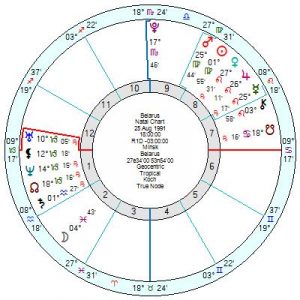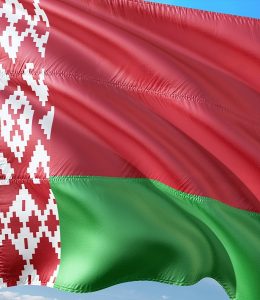Belarus, known as the last dictatorship in Europe is in uproar as the rolling presidency of strongman Alexander Lukashenko, at the helm since 1994, notched up another rigged election win. A landlocked country of 9.5 million inhabitants, with Poland to the west, Russia to the east, Ukraine south and Lithuania, Latvia to the north, it has been badly hit by economic mismanagement and the pandemic.
Belarus’s history is complicated though it became a founding member of the Soviet Union post-1917. They suffered unthinkable losses during World War 11, estimated to be 25% of its population when Nazi Germany invaded the USSR. About 85% of the capital Minsk was destroyed in bombing raids. The Chernobyl nuclear accident in 1986 also had a devastating effect on the country which suffered the worst of the radioactive fallout – about 70% of the hazardous particles it created landed there. Two million people in Belarus, 500,000 of whom are high-risk, live in heavily contaminated zones.
A Bolshevik regime was established in Belarus on 1 August 1920. That chart has Sun, Mercury, Neptune in Leo and Jupiter Neptune also in Leo which makes it sound like a Caribbean festival. But what marks it out as high-risk is a Grand Trine of ruthless Mars in Scorpio trine Pluto trine Uranus – rolling drama and cruelty. The Grand Trine is formed into a Kite by an autocratic Uranus opposition Saturn in Virgo. Mars is also square the Sun Neptune.
What is worrisome is that during World War 11 tr Pluto in Leo was then moving across the Belarus 1920 Sun Neptune; and in 1986 tr Pluto had moved on a quarter cycle into Scorpio to form another hard aspect to the Sun. That scenario will repeat in the late stages of this decade with tr Pluto then into Aquarius.
The chart for modern Belarus, 25 August 1991 6pm (unverified) Minsk, Belarus, has, if the time is accurate, a control-freak Pluto on the Midheaven with a highly-strung Uranus Neptune on the Capricorn Ascendant; with an 8th house Virgo Sun and Mars also in Virgo; plus a Mercury, Jupiter, Neptune in Leo which echoes the 1920 chart.
The way ahead is beset by pitfalls with a revolutionary tr Uranus opposition the Pluto in 2022, and a panicky-failure tr Neptune opposition the Mars in 2023 along with a deprived, discouraging slog from tr Pluto conjunct Saturn in 2024/25.
Predicting the downfall of dictators is always a mug’s game since they usually have the tenacity of cockroaches.
Lukashenko, 30 August 1954, is a Sun Virgo trine Mars in Capricorn, sextile Saturn in Scorpio – ambitious, hard-edged, obsessive, not prone to sharing the driving seat with others. He’s also got a lucky Jupiter Uranus in Cancer in a can-be-fanatical square to Neptune Venus. He’s in a devastated muddle at the moment and in 2021 with tr Pluto square his Neptune and in a state of upheaval in 2021/22 with tr Pluto opposition his Uranus – so he could go, but if anything his worst years look like 2023/24.
His first presidency chart, 20 July 1994, is under severe stress now and on for another three years with the tr Saturn Pluto this year in hard aspect to the Cancer Sun opposition Uranus – and it will continue in turmoil through 2021 and worse in 2022/23; with topple-off-perch influences (if he’s still there) by 2024.
I may be wrong but it looks as if the chaos will run on for another few years yet.
The opposition leader, Svetlana Tikhanaovskaya, has fled to Lithuania, understandably given the president’s propensity of labelling protesters as terrorists, saying: “We will wring their necks, as one might a duck.” Her children had been sent ahead of time and her activist husband appears to be under arrest.
She was born 11 September 1982 and is an idealistic Sun Virgo square Neptune, sextile Mars in Scorpio, with a tough-minded Saturn Pluto in Libra. She looks deflated and discouraged through the next two and a half years with one minor uptick from tr Uranus opposition her Jupiter in Scorpio in November/December and February 2021.







You have to abide by certain rules to be in the European Union right? I get the impression the former soviet bloc countries rely on the European Union economy for their economies. So I expect changes in the future regardless of the long time President.
Belarus is probably the last isolationist state in Europe. It’s also the only country in Europe that still offers the death penalty (only male criminals though). I was always fascinated with the Soviet Union, so I have been studying the history of every former Soviet Republic for years. Belarus is truly a unique case. The Belarusian people are recognized as a separate ethnic group and the Belarusian language is recognized as a separate language with it’s own vernacular. However, the Belarusian people seem to be much less nationalistic than other nationalities and ethnic groups of the former Soviet Union.
For example, in 1991, when the Soviet Union began dismantling. Nationalist movements immediately broke out in Moldova (Transnistria), Georgia (Abkhazia), and Tajikistan. A few years later, in 1994, nationalist movements began springing up in the Russian Federation’s federal subject of Chechnya and Ingushetia. Now it’s Eastern Ukraine and Crimea. Belarus has managed to avoid all of this.
Belarus decided to join the newly formed Commonwealth of Independent States in December 1991 (the only European former Soviet Republic besides Moldova to do so) and there has been little interest in joining the European Union.
There doesn’t appear to be too much opposition to Alexander Lukashenko either. He’s ruled Belarus since 1994…and he isn’t showing any signs of stepping down anytime soon.
All in all, I just find it interesting how Belarus has managed to avoid the Slavic nationalist movements of the 1990s. The Socialist Federal Republic of Yugoslavia violently dismantled in 1991 with the wars of succession in Slovenia, Croatia, and Bosnia and Herzegovina, Czechoslovakia peacefully dismantled in 1993 with the “Velvet Divorce” and Slovakia became it’s own sovereign state, and Ukraine is still struggling to remove itself from Russia’s shadow.
Anyway, we have a sizable Belarusian community here in Jacksonville, Florida (many settled here in the late 1990s and early 2000s) and I know some of them personally. They all speak Russian instead of Belarusian and they seem to identify more with “Russia” than “Belarus” despite all of them identifying as “ethnic Belarusians” It’s interesting…to say the least.
Chris Romero
Jacksonville, Florida, U.S.
So does mine.
The history of time zones in Russian Empire and Soviet Union is complicated, and not all programs can be trusted to convert them correctly at all times. Yours shows Daylight Saving for Tikhanovskaya,though, but not for Lukashenko, which would be correct, since it was introduced to Soviet Union only in 1981, so that’s good.
The ones I might have issues with here are 1920 and 1991 Belarus Charts. In Russian Empire, Solar Time was used commonly till 1880, when Moscow Mean Time, +2.30 GTM was introduced, but many parts of The Empire continued to use Solar Time. At Minsk, that would be almost exactly +2 GTM. After The Revolution, Moscow time GTM +2 was used for a while before settling to GTM +3 for Western Parts. And there was a near anarchy with these during Revolution, so one should always allow an “ish” with these and if possible, rectify.
With 1991 chart, I’m almost certain Belarus continued to stay in Moscow time, with Daylight Saving for a while, so a July chart should be R2D +4, like Tikhanovskaya’s. This actually became a political issue when Baltic States first gained independence. They couldn’t wait to pass to +2. Also, this is an ongoing argument by Belarus Opposition – Lukashenko keeps them, literally, on Moscow time, even if Minsk is 27e, and Grodno and Brest 23e, West of Helsinki and Tallinn.
Hi Marj, please recheck your time zone for BELARUS, my Solar Fire is giving BAT -3.00 for the time zone.